 |
 |
 |
| |
Identifying Patients Infected With HCV Genotype 1 Who May Benefit From Extended Peginterferon Alfa-2a/Ribavirin Therapy Beyond 48 Weeks
|
| |
| |
EASL April 23-26 2009 Copenhagen
Reported by Jules Levin
Donald M. Jensen, MD1; Fayez M. Hamzeh, MD, PhD2; Ellen Lentz, PhD2; Nancy Reau, MD1
1University of Chicago Medical Center, Chicago, IL; 2Roche, Nutley, NJ
INTRODUCTION
Treatment for 48 weeks with peginterferon alfa-2a plus ribavirin produces sustained virologic response (SVR) in 46% to 52% of patients infected with hepatitis C virus (HCV) genotype 1.1,2
This suggests that approximately 50% of patients:
- Fail to respond to treatment
- Having become HCV RNA undetectable, subsequently become HCV RNA detectable while on treatment (breakthrough)
- Having become HCV RNA undetectable, relapse during the 24 weeks after the end of
treatment (EOT)
- Discontinue treatment early.
Studies have shown that treatment for >48 weeks with peginterferon alfa-2a plus ribavirin may reduce relapse in HCV genotype-1 infected patients who did not achieve rapid virologic response (RVR) at 4 weeks.3,4
The objective of this analysis was to develop a model that can be used to identify non-RVR patients who may be candidates for extended treatment duration.
Author CONCLUSIONS
The practice of treating all patients without cEVR but undetectable HCV RNA at Weeks 13-24 was less accurate, but may be the most practical, when compared with the optimal model.
Week 4 HCV <2 log10 reduction was the earliest marker of candidates for extended treatment duration but the least accurate.
However, prospective clinical trials are necessary to confirm the benefit of extended treatment duration.
Author DISCUSSION
The optimal model provided acceptable sensitivity and specificity to identify patients who will relapse and therefore may benefit from extended treatment duration.
Age, ethnicity, time to first HCV RNA undetectable, baseline ALT level, baseline HCV RNA level, cirrhosis, and HCV RNA reduction at Weeks 4 and 12 were included in the optimal model to predict relapse among patients who were non-RVR and HCV RNA undetectable at EOT.
METHODS
Patients
Analysis included patients from four clinical trials (NV15801, NV15942, NR16172, and ML18179)1,2,5,6 who were infected with HCV genotype 1 and randomized to treatment for 48 weeks with 180 µg/week peginterferon alfa-2a plus 1000 or 1200 mg/day ribavirin.
Patients were eligible for this analysis if they:
- First became HCV RNA undetectable at Weeks 5-12 (cEVR, complete early virologic responders) or at Weeks 13-24 (undetectable at Week 24)
- Were HCV RNA undetectable at Week 48 (EOT)
- Had a HCV RNA measurement at Week 72.
Depending on their virologic response at Week 72, patients included in this analysis were those who became HCV RNA undetectable between Weeks 5 and 24 who had either SVR or confirmed relapse.
All patients who met the analysis criteria completed 48 weeks of treatment. Two patients who discontinued early due to adverse event or illness were excluded from the analysis.
Two of the trials included in the analysis were enriched with patients who had characteristics traditionally associated with a decreased treatment response:
- NR16172: includes 78/106 patients of African American ethnicity5
-- ML18179: includes 268/567 patients of Latino white ethnicity.6
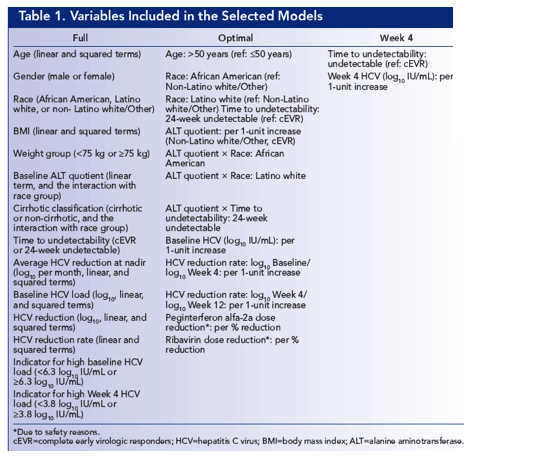
Outcome Variable and Candidate Predictors
The outcome variable for this analysis was relapse that was defined as 'Yes' if HCV RNA was detectable at Week 72 following HCV RNA being undetectable at EOT.
- Undetectable HCV RNA was defined as <28 IU/mL (Roche High Pure System/COBAS® TaqMan® HCV Monitor Test) in the most recent study,6 and <50 IU/mL (Roche Amplicor PCR assay) in the three earlier studies.1,2,5
Candidate predictors that were potentially associated with relapse and were therefore included in the analysis were patient demographics and clinical characteristics at baseline, time to first HCV RNA undetectability (ie, cEVR vs. undetectable at Week 24), HCV RNA reduction at Weeks 4, 12, and 24, and average HCV RNA reduction at nadir.
Statistical Analysis
Descriptive Statistics and Univariate Analysis
-- Patient demographics and clinical characteristics at baseline were provided for the overall sample population.
-- Mean HCV RNA load (log10) was evaluated by time point and SVR/relapse status for the overall sample, the cEVR patients, and the patients who became undetectable at Week 24.
-- The relationship between baseline and HCV reduction variables and relapse was evaluated using univariate logistic regression analysis.
Model Development
-- Logistic regression analysis was used to develop a model to predict relapse at Week 72.
-- Descriptive statistics (eg, percentages and means) of the candidate variables were reviewed and their relationship with relapse was evaluated using simple logistic regression one at a time.
-- Multiple variable models were selected starting from a full model that included all candidate variables and their meaningful interactions (Table 1). A backward selection procedure was used with P<.20 for elimination. The models obtained after this backward selection were further refined for simplicity and robustness.
- Percentage dose reduction (as a continuous variable) due to safety reasons was incorporated into the optimal model using a backward selection procedure that eliminated the insignificant (P>.05) variables one at a time.
Model Evaluation and Comparison
-- The selected models were evaluated using receiver operating characteristic (ROC) curves, sensitivity (% of patients correctly predicted as relapse), and specificity (% of patients correctly predicted as SVR).
-- To further demonstrate the improvement in prediction, selected models were compared with the practice of treating all patients who became undetectable at Week 24 and leaving cEVR patients without further treatment.

Patient Demographics and Clinical Characteristics
In total, 539 patients were eligible for inclusion in this analysis.
Demographics and clinical characteristics of these patients are presented in Table 2.
The proportion of patients that became HCV RNA undetectable during Weeks 5-12 (cEVR) was 72.0% (n=388), and during Weeks 13-24 (undetectable at Week 24) was 28.0% (n=151).

Model Development
Results from the univariate analysis (Table 3A and 3B) suggested that variables associated with relapse included age, ethnicity, HCV RNA at baseline, cirrhosis, time to first HCV RNA undetectable, HCV RNA reduction at Weeks 4, 12, and 24, and average HCV RNA reduction at nadir (≥0.5 log10 per month).
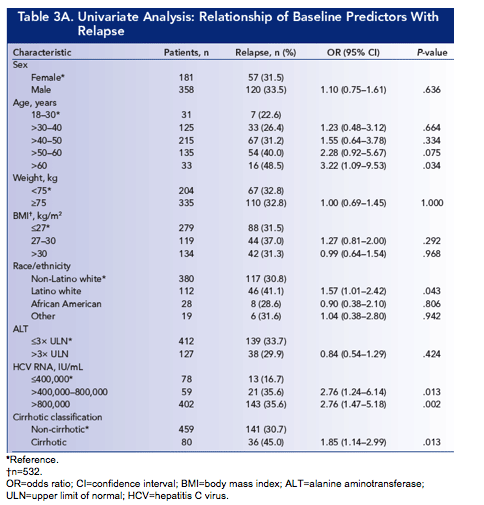
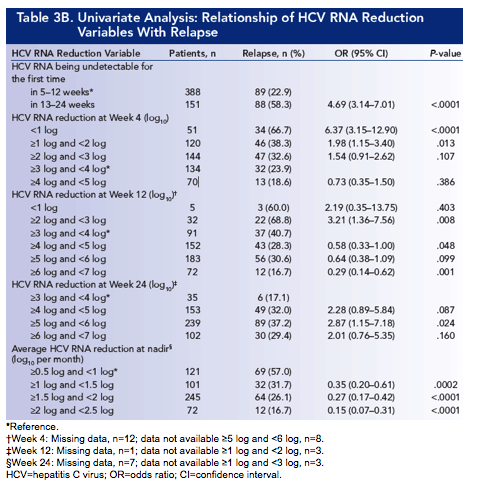
Using a backward selection procedure starting with the full model, several less complex multivariable logistic models containing fewer variables were developed to predict relapse.
Models included an optimal model and a Week-4 model (Table 1).
The variables and the parameter estimates included in the optimal model are presented in Table 4.
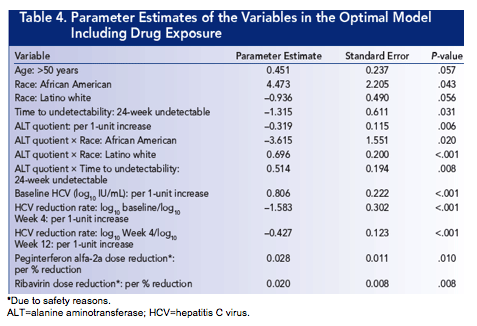
Evaluation of the Optimal Model
The ROC curve derived from the optimal model is presented in Figure 1. The curve was far from the diagonal straight line indicating that the optimal model was valuable in predicting relapse.
It is known that the sensitivity increases and the specificity decreases as a lower cut-off point is chosen for the predicted probability in the model (ie, more patients are predicted as relapse).
Therefore, it is necessary to select a reasonable cut-off point when making a prediction to
balance between the gain in sensitivity and the loss in specificity.
-- When using a cut-off point of .509 in predicted probability, the optimal model had a sensitivity of 50% and a specificity of 89%. When using a cut-off point of .406 in predicted probability, the optimal model had a sensitivity of 63% and a specificity of 82%.

Comparing the Optimal Model with Methods in Practice
Two methods were used to compare the optimal model with methods in practice:
- Extending treatment duration for all patients who became undetectable at Week 24 (ie, predicting them as relapse) and leaving cEVR patients without further treatment (ie, predicting them as SVR)
-- Extending treatment duration for all patients with Week 4 HCV RNA <2 log10 reduction and leaving other patients without further treatment.
When applying these two methods to the analysis sample, the first method provided a sensitivity of 50% and a specificity of 82%, which were greater than the second method (Table 5).
Compared with the practice of extending treatment duration for all patients who became undetectable between Weeks 13 and 24 and leaving cEVR patients untreated, the optimal model provided higher specificity (by 7%) when the sensitivities were the same, and higher sensitivity (by 13%) when the specificities were the same. Thus, the optimal model predicted 7% more true SVR or 13% more true relapse than extending treatment duration for all patients who became undetectable at Week 24.
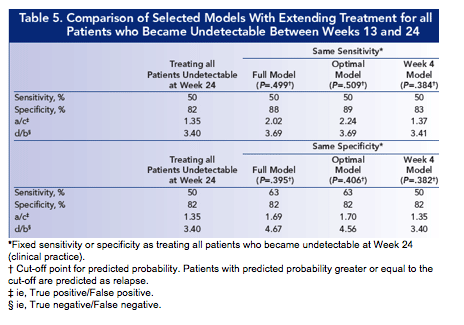
|
| |
|
 |
 |
|
|